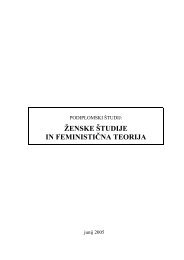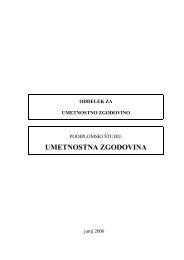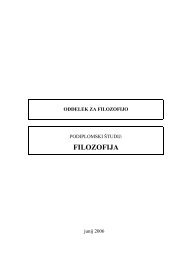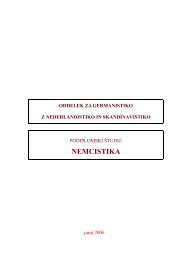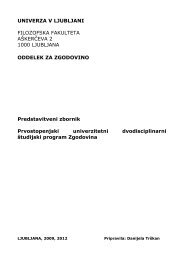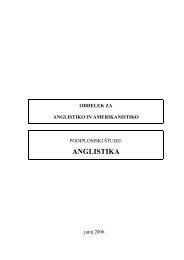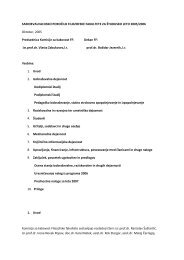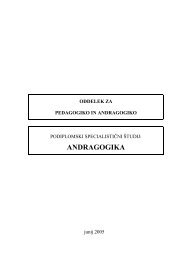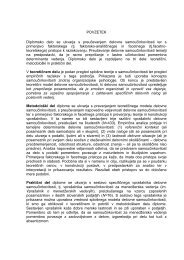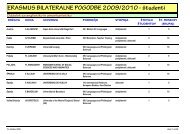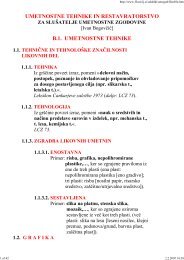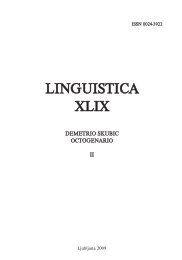B_solo_zgibanke male new_1 - Filozofska fakulteta
B_solo_zgibanke male new_1 - Filozofska fakulteta
B_solo_zgibanke male new_1 - Filozofska fakulteta
Create successful ePaper yourself
Turn your PDF publications into a flip-book with our unique Google optimized e-Paper software.
cannot be extended to the right; i.e., if there is no such value that would be even less<br />
natural than value B.<br />
an example. in the scale >nat (main, dependent) / clause, the value “dependent<br />
clause” is an unnatural environment because the scale cannot be extended to the<br />
right. this means: all deductions whose language data lie within the environment<br />
“dependent clause” require the implementation of chiastic alignment.<br />
Chiastic alignment is prohibited when a naturalness scale is substantiated with<br />
an axiom. if, however, an axiom is engaged as one of the scales in a deduction, it<br />
obeys the usual distribution of the alignment rules.<br />
the insistence of Natural Syntax on the distinction between parallel and chiastic<br />
alignments stems indirectly from the work of Henning andersen within markedness<br />
theory. andersen observes situations such as the following in all human semiotic<br />
systems: on an everyday occasion casual wear is unmarked, and formalwear marked;<br />
on a festive occasion it is the formalwear that is unmarked, whereas casual wear is<br />
marked. See andersen 1972: 45, esp. fn. 23. this example expressed with our scales:<br />
(i) >nat (casual, formal) / wear, (ii) >nat (–,+) / marked. a third scale as the source<br />
of the environment of the deduction: >nat (everyday, festive) / occasion. if the<br />
environment is “everyday occasion”, the alignment within (i–ii) is parallel; if the<br />
environment is “festive occasion”, the alignment within (i–ii) is chiastic.<br />
this paper deals with an important morphophonological question of Standard<br />
French grammar: with what is known as “liaison(s)” in French. i hope that it will be<br />
seen that Natural Syntax is capable of achieving as much outside syntax as within it.<br />
it has in fact been my tacit hope for some time that Natural Syntax can be extended<br />
at least to the phonology and morphophonology of any language.<br />
as is well known, liaison is realized only between two words in contact; more<br />
precisely, in contact in which the second word begins with a vowel. Regarding the<br />
(un)naturalness of such word onset, consider the scale >nat (consonant, vowel) / first<br />
segment of a word. this scale is supported by the well-known observation that basic<br />
syllable structure is Cv; that is, consonant + vowel. Based on this it follows that,<br />
whenever a vowel as the initial segment of a word constitutes the environment of<br />
some deduction, such an environment is unnatural; consequently the alignment of<br />
the corresponding values of the scales of that deduction must be chiastic. this is the<br />
essential aspect from the standpoint of the SeCOND word in contact.<br />
What is the role of the FiRSt word in contact? its final segment(s) always<br />
participate(s) in the decision on whether the conditions for liaison obtain. For<br />
instance, in the masculine adjective grand ‘large’ the conditions obtain and liaison is<br />
in principle permitted, whereas in the feminine form grande the conditions for<br />
liaison are not met, hence liaison is not permitted. this permanent property of the<br />
final segment(s) of the first word in contact is completely independent of liaison<br />
proper, and therefore it can be left out of consideration here. However, it is still<br />
possible that some additional feature of the first word helps decide whether liaison<br />
will take place. For instance, it is sometimes important that the first word is a<br />
36



